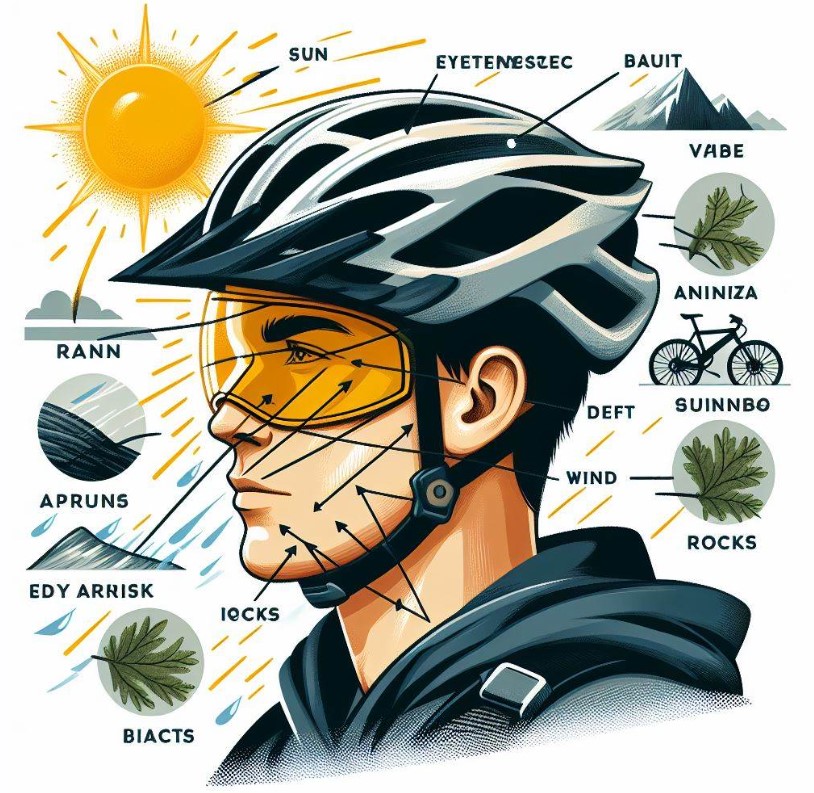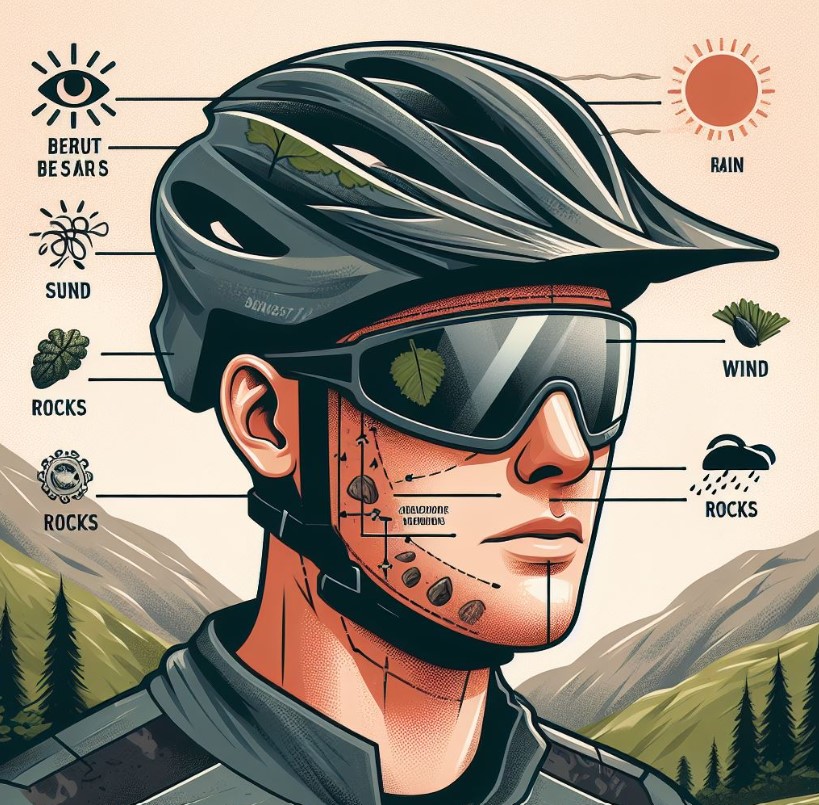Why Do Mountain Bike Helmets Have Visors? Answered
This article aims to provide information on Why Do Mountain Bike Helmets Have Visors? Mountain bike helmets are equipped with visors for enhanced safety and comfort during rides. These features are crucial for protecting a rider’s eyes from the sun’s glare, debris, and weather elements. Visors improve visibility and focus, essential for navigating challenging trails. Understanding the importance of visors can help riders choose the right helmet for their mountain biking adventures.
Key Takeaways
- Visors protect the eyes from the sun, enhancing visibility.
- They shield the face from debris and elements.
- Visors differ in size and adjustability based on helmet design.
Why Do Mountain Bike Helmets Have Visors?
Mountain bike helmets have visors primarily to protect the rider’s eyes from the sun, debris, and elements, enhancing visibility and safety during rides.

Protection from Elements
Mountain bike helmets with visors offer essential protection from various elements. Firstly, they shield the rider’s eyes from the harsh rays of the sun, reducing glare and allowing for better visibility during rides.
This is crucial for safety and comfort, especially when navigating through challenging terrains. Secondly, visors protect against rain, wind, and even snow, ensuring the rider’s vision remains clear in different weather conditions.
Moreover, the visor acts as a barrier against low-hanging branches, mud, and other debris encountered on trails. This added layer of protection helps prevent accidents and injuries, allowing riders to focus on the trail ahead.
The size and shape of the visor can vary among helmets, with some offering greater coverage and others designed for more lightweight and less obstructive features.
Enhanced Comfort and Visibility
Apart from protection, visors on mountain bike helmets contribute to enhanced comfort and visibility. By blocking out the sun and elements, riders can avoid squinting and discomfort, leading to a more enjoyable and focused riding experience.
The angle and adjustability of the visor can be tailored to the rider’s preference, ensuring optimal shielding and visibility based on the sun’s position and trail conditions.
Visors also play a role in managing sweat and rain, diverting them away from the eyes and glasses. This is particularly beneficial during intense rides or in hot and humid conditions, where sweat can significantly impair vision.
By improving comfort and visibility, visors help riders maintain concentration and control, which is vital for safe mountain biking.
Aesthetic and Design Considerations
Mountain bike helmets with visors are not only functional but also aesthetic. The design of the helmet, including the visor, contributes to the overall look and style of the rider.
Visors add a rugged, adventurous aspect to the helmet, reflecting the dynamic nature of mountain biking. They come in various shapes, sizes, and colors, allowing riders to personalize their gear and express their style.
Furthermore, the integration of the visor into the helmet’s design is carefully considered to ensure aerodynamics and balance. While providing essential protection and comfort, the visor should not interfere with the rider’s performance or cause unnecessary drag.
Designers strive to create helmets that are both stylish and functional, catering to the diverse preferences and needs of mountain bikers.
Types of Visors and Compatibility
Visors on mountain bike helmets vary in type and compatibility. Some helmets feature fixed visors, which are permanently attached and offer consistent protection.
Others come with adjustable visors, allowing riders to change the angle and amount of coverage based on their needs and conditions. The choice between fixed and adjustable visors depends on personal preference and the type of riding.
Additionally, the compatibility of visors with other riding accessories, such as goggles and glasses, is a crucial consideration. Many mountain bike helmets are designed to accommodate eyewear, ensuring that the visor does not obstruct or interfere with the rider’s glasses or goggles.
This compatibility is essential for riders who require vision correction or additional eye protection, enhancing the overall usability and functionality of the helmet.
Safety Standards and Regulations
Safety is a paramount concern in the design and manufacture of mountain bike helmets and visors. Helmets must meet specific safety standards and regulations to ensure they provide adequate protection in the event of a crash or impact. The visor is part of the helmet’s safety features, designed to break away or deform upon impact to prevent further injury.
Manufacturers must balance the visor’s protective function with its potential to cause harm during a crash. Therefore, the materials, attachment mechanisms, and overall design of the visor are subject to rigorous testing and standards.
Riders should ensure their helmet and visor meet these safety requirements, contributing to their overall well-being and peace of mind while riding.
What Is The Visor For On A Mountain Bike Helmet?
The visor on a mountain bike helmet serves multiple purposes, primarily aimed at protecting the rider’s eyes and face. It shields against the sun’s glare, improving visibility during rides in varying light conditions.

The visor also acts as a barrier against rain, wind, and flying debris such as branches, leaves, and dirt, which are common on mountain trails. Additionally, it can help to deflect branches and prevent them from striking the rider’s face, enhancing safety.
These features are crucial for mountain biking, where varied terrain and environmental conditions can significantly impact visibility and comfort.
Why Do Trail Helmets Have Visors?
Trail helmets have visors primarily for the enhanced protection they offer in off-road conditions. Trail riding often involves navigating through uneven and unpredictable terrain, where riders can encounter low-hanging branches, mud splashes, and strong sunlight through tree canopies.
The visor helps to protect the rider’s eyes from these elements and prevents glare, which can lead to improved focus and a safer riding experience.
Furthermore, trail helmets with visors are designed to complement the aggressive riding style and additional head coverage typical of trail riding, offering a balance between protection, visibility, and comfort.
Why Don’t Road Bike Helmets Have Visors?
Road bike helmets typically do not have visors for several reasons. Aerodynamics is a crucial factor in road cycling, and visors can create additional wind resistance that can slow a rider down. Road cyclists also usually maintain a head-down position that makes a visor less useful and more likely to obstruct vision.

Furthermore, road biking conditions generally involve well-maintained paths and fewer overhead hazards, reducing the need for the protective features that visors provide. Instead, road cyclists often wear sunglasses to protect their eyes from the sun and debris, which allows for more streamlined helmet designs.
Why Do MTB Helmets All Have To Have Enormous Visors?
The size of the visor on MTB helmets is directly related to the level of protection and visibility needed in mountain biking. Larger visors offer more coverage against the sun, rain, and debris, which are common in mountain biking environments.
The extensive coverage helps to manage the diverse lighting conditions and protects against larger particles or obstacles that riders might face on rough terrains.
However, the size can vary based on the helmet’s design and the intended use. While larger visors are common, not all MTB helmets feature oversized visors; the design depends on the balance between protection, visibility, and personal preference.
Conclusion
In conclusion, visors are a vital component of mountain bike helmets, offering crucial protection and comfort for riders. They shield eyes from harmful elements and improve visibility, which is essential for the unpredictable conditions of mountain biking. By understanding the functionality and benefits of helmet visors, riders can make informed decisions and enjoy a safer, more comfortable riding experience.
People Also Ask
Does the color of the visor affect visibility?
The color of the visor can affect visibility under different lighting conditions. Clear visors are versatile for various conditions, while tinted or colored visors can enhance contrast and reduce glare in bright sunlight. Consider the typical riding conditions and choose a visor color that provides the best visibility and comfort for your environment.
How do I adjust the angle of my mountain bike helmet visor?
To adjust the angle of your mountain bike helmet visor, loosen the attachment points slightly, reposition the visor to your desired angle, and then re-tighten. Some helmets feature a ratchet or other mechanisms for easier adjustment. Refer to the helmet’s manual for specific instructions.
Do mountain bike helmet visors provide UV protection?
Many mountain bike helmet visors are designed to provide UV protection, reducing eye strain and protecting against harmful ultraviolet rays. However, the level of protection can vary, so it’s recommended to check the visor’s specifications or contact the manufacturer for detailed information.
Can I replace a broken visor on my mountain bike helmet?
Yes, in most cases, you can replace a broken visor on your mountain bike helmet. Manufacturers often offer replacement visors that you can purchase separately. Ensure the replacement is compatible with your helmet model for a proper fit and optimal protection.

Welcome to the exhilarating world of Matt Rex, a professional car racer turned renowned vehicle enthusiast. Immerse yourself in his captivating blog as he shares heart-pounding adventures, expert reviews, and valuable insights on cars, trucks, jets, and more. Fuel your passion for speed and discover the beauty of vehicles through Matt’s engaging stories and meticulous expertise. Join the ever-growing community of enthusiasts who find inspiration and expert advice in Matt Rex’s blog—a digital hub where the thrill of speed meets the pursuit of knowledge.



![How Fast Does A 70CC Pit Bike Go? [Answered]](https://www.turbochaos.com/wp-content/uploads/2024/02/How-Fast-Does-A-70CC-Pit-Bike-Go-768x698.jpg)



